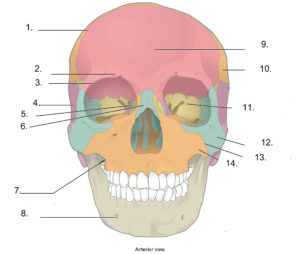The Head and Neck
Chapter Conclusion
Learning objectives
- Identify the bones that comprise the cranium.
- Identify the major movers of the head and neck and understand the actions of the separate groups of muscles within the head and neck.
- Identify the 12 the cranial nerves and the acronyms associated with them as well as there functions.
- Identify the nerves that innervate the major movers of the neck, with emphasis on the brachial plexus.
- Identify the 5 lobes of the brain and understand the order of the ventricles that are within the brain superiority to inferiorly.
- Identify the hypothalamus and pituitary gland relative to the anatomy of the brain
- Identify the thyroid gland and its function
Part A
1. How many bones make up the adult skull?
a) 17
b) 8
c) 22
d) 18
2. The two superficial anterior muscles of the neck are________.
a) Sternothyroid and Stylohyoid
b) Sternocleidomastoid and Subscapularis
c) Platysma and Stylohyoid
d) Sternocleidomastoid and Platysma
3. The cranial nerve responsible for speech chewing and swallowing is________.
a) Olfactory
b) Abducens
c) Hypoglossal
d) Vagus
4. the suboccipital cervical muscles primary function is ________.
a) To stabilize the head and neck.
b) Create neck flexion
c) Creat neck extension
d) None of the above
5.Trace the steps in the release of the hormone estrogen starting at the hypothalamus
a) Hypothalamus – Anterior pituitary gland – FSH – Testes – Estrogen
b) Hypothalamus – thyroid – OXT – female uterine – Estrogen
c) Hypothalamus – Anterior pituitary gland – FSH – Ovaries – Estrogen
d) Hypothalamus – TSH – Thyroid gland – Ovaries – Estrogen
Part B
Part B label the diagram using the word bank
a)Coronal suture g) Supraorbital foramen
b)Supraorbital h)marginTemporal bone
c)Ethmoid bone i)Nasal bone
d)Maxilla j) Frontal bone
e)Partial bone k)Obit
f) Zygomatic bone L)Mandible

Part C
For the following question match the function to the cranial nerve
|
|
Answer Key
Part A
1)C. 2)D. 3)C. 4)A. 5)C.
Part B
1)A. 2)G. 3)B. 4)H. 5)C. 6)I. 7)D. 8)J. 9)E. 10)K. 11)F. 12)L.
Part C
1)K. 2)G. (3-4 and 5)C or E or F. 6)A. 7)B. 8)D. 9)H. 10)J. 11)I. 12)L.

